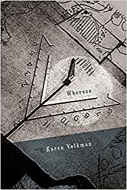 Karen Volkman
Karen Volkman
Whereso
BOA Editions
Reviewer: Wynn Yarbrough
Karen Volkman has published books now for over eighteen years. In that time, her four collections of poems have varied in formal arrangements and stylistically in terms of line length and compaction. Her previous releases—Crash’s Law (1998), a mix of forms; Spar (2002), a mixed prose form collection; and Nomina (2008), a body of Petrarchan sonnets—all reveal an artist cracking and sifting through the mind’s connection to the finite (sensory details of daily life) and the infinite (eternal preoccupations with death, comprehension of self among life and the ruins of life). Her latest collection, Whereso, is no different in its concerns.
Volkman never reads, at least to me, as if she is particularly concerned with transparency. Seeing clearly, for her, would be tantamount to seeing inaccurately, neglecting to gesture towards overwhelming and frightening apprehension of the ephemera of life. Much of the opaqueness in her poems is accomplished through a particular use of language, grammar, and syntax. But her transparency relies on the very same tools. That collision between sense and sight, thought and feeling, form and content demonstrates that her “fractures” and tests of the “will” aren’t mere exercises. Her work constantly arcs towards a “machine” through which she filters her perceptions of the world and through which the reader encounters her statements and descriptions.
Volkman records the strange experiences of trying to work towards understanding or at least awareness, even if that awareness is necessarily limited. There may be an absence of a “bridge,” but that doesn’t stop the apprehending machines of the mind:
Creek’s uncrossability, a new beauty.
“It looked like the process of a thinking,
deep run.” It became the suffering of form
and mute suggestion. The syllables
were not perennial. They broke and grew. (“Bridge”)
Much of Volkman’s writing is indeed processed cerebrally, yet it also compels more than just an intellectual response. The arrangement of the images begins to correspond, in many poems, with reactions to the senses and the body. For example, in “Stranger Report,” Volkman offers the mind and body for the “purpose”:
We are your auditors,
calculating ruptures, in the invisible lines determining
movement as pattern, this precision beyond a norm.
Articulate body, a violent order, a stranger
rapport which finishes as stage and process.
Record.
The work with allusions, imagery, and displacement lends a tone of antiquity, the invocation of a self that is constantly in development, but has to be reconciled with so much geologic and cultural evolution. This multifoliate layering of her work crosses film, travel, depression, myth, ballet, and a host of other “subjects.” In this displacement and reconciliation, there are always speakers who remain open and vulnerable, the mind’s nerve endings visible.
This is evident even in the identification of the self in pronoun work: the opening “One Might” works through she, I, you, and our in intimate feminine perspective, but how someone (a persona) is revealed lies in a journey from “One might start here, with the blank specimen, not thinking too much” to “there have to be these and those, swoops and frays.” Volkman demonstrates how the subject/object dynamism of consciousness is a rich battle and surrender—a rich interplay of the changing self among the living and the ruins.
There is much to say about poesis and what it means to make in Whereso. In various poems, the art of making is on display:
“Some hysteric / trope of repetition, rage for accretion, /dazed by its own mute replication” (What I’ve Come to Discuss).
“I’m never sure / of after or before” / rhymes the child-mind / in its habiting of eliding” (The City’s Transparency).
“I am merely / a carpenter, a crafter / of magics, says someone, a secret / practice” (The Queen’s Queen).
But there is excess in her work, and a reader will have to deal with that. Many of the writers I admire (Hart Crane, Dylan Thomas, Harryette Mullen) “fork lightning” with their syntax, accretion, and verve. The excess, in this collection, can take over a poem where the exceptional image repeats and obscures. In “I Went to Sign,” Volkman’s prose poem “draws” the narrator into that micro-reflection of the finger next to the immensity of the sky. But does the narrator “give so much of gray grievance as fits a rock’s mouth, a raw rock gaping its chambers?”
I don’t want to give away the poem because the ending is spectacular. I also don’t want the reader to be unprepared. There are many poems in this collection that require attentive and persistent reading; however, there is a reward for the efforts. I would say, as with Crane, Thomas, and Mullen, the excess “leads to the palace of wisdom,” and the poems have the potential to transport one, I’ve found, towards an experience of ecstasy.
The last section of the book is loaded with gems. Two ghazals, frighteningly good, have haunted me for weeks now. “Ghazal of a Life” with “that gambler with the razzled hair and weedy eye— / watch her place her bets on this scheming rhyme of a life” and “Ghazal of the Dead” with “Steven S., dead of AIDS at 26, first showed me Dawn of the Dead,” both demonstrate a linguistic prowess and litheness—and humor, lots of it.
There has never been an author whom I’ve read who flummoxes me the way Volkman does. Every time I read her work I have to stop and go back—every time. And every time I do this, I read with awe in subsequent readings. She frustrates me with intricacy, but rewards me with days, weeks, years of spinning in that wondrous state you access when you read something profound. It will be interesting to see how much Volkman leans into new pagination and forms in her next collection, but for now we are lucky to have this book, sublime and radiant as it is.

